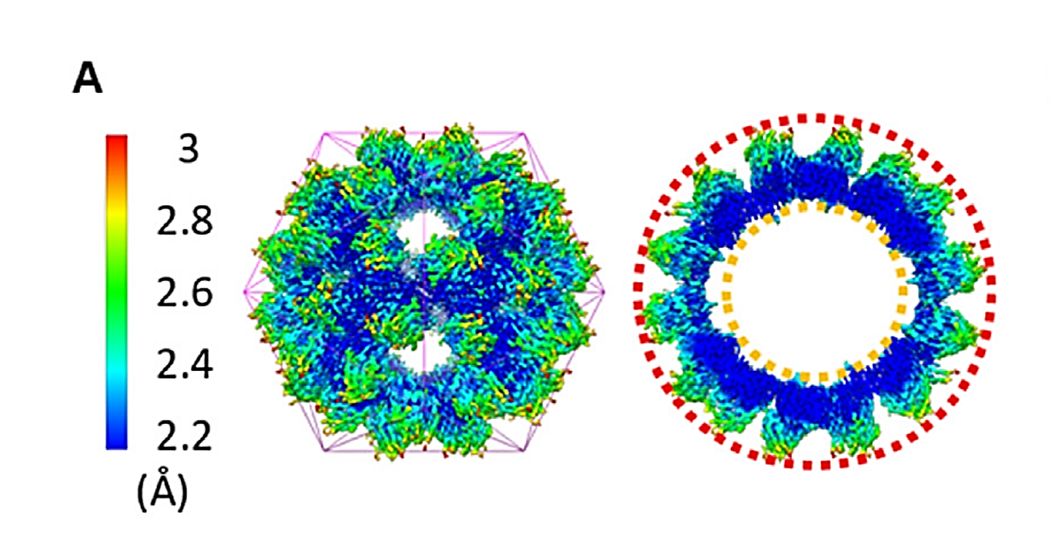Structural Research of Alfalfa Mosaic Virus
Alfalfa mosaic virus (AMV) of the family Bromoviridae is an essential economic pathogen with a worldwide presence and a very wide host range. AMV is spread by sowing infected seeds or transferring aphid vectors from infected to healthy plants. In recent years, virus-like particles (VLPs) of plant viruses have been used to develop vaccines against human and animal diseases. Research on plant virus VLPs expands their potential applications and increases understanding of their structural and functional properties, facilitating the development of innovative solutions in areas such as vaccinology, drug delivery, and nanotechnology.
 Figure 1. The overall structure of AMV VLPs. (Jeong H, et al., 2021)
Figure 1. The overall structure of AMV VLPs. (Jeong H, et al., 2021)
Structural Features of Alfalfa Mosaic Virus
AMV is a complex virus consisting of four different types of particles, including three rod-shaped particles and one spherical particle. Of these, the rod-shaped particles range in length from 30 to 57 nm and are characterized by a hemispherical end with pentagonal symmetry and a cylindrical portion with hexagonal extensions in various configurations. AMV contains a single-stranded RNA genome consisting of three parts: RNA1, RNA2, and RNA3. In addition, the sub-genomic RNA4 is produced by transcription of the RNA3 negative-sense strand. Each of these genomic RNAs is encapsulated within rod-shaped particles along with RNA4. RNA1 and RNA2 each contain an open reading frame (ORF) encoding the viral replicase subunits P1 and P2, respectively. movement proteins and capsid proteins (CP) are encoded by two ORFs within RNA3. RNA4 or AMV-CP translation products are essential for RNA replication, viral RNA packaging, transmission, and infection.
Medicinal Potential of AMV Virus-like Particles
Virus-like particles contain viral capsid proteins that self-assemble and mimic the shape and size of real viral particles, and since they contain no genetic material, they cannot infect host cells. VLPs have great potential as safe drug candidates/vectors and, as a result, they are becoming increasingly popular in the fields of preventive medicine and therapeutics. Researchers used Nicotiana benthamiana tobacco as an expression platform for the production of alfalfa mosaic virus capsid protein (AMV-CP), confirming the optimal conditions for the formation of rAMV-CP VLPs and confirming the structure at 2.4 Å resolution by cryo-electron microscopy (cryo-EM) analysis, which will provide a useful platform for the development of a variety of new drugs.
Highlights of Plant Virus VLP
- Engineering and design: Researchers have made progress in engineering plant virus VLP to enhance its stability, immunogenicity, and versatility. Through genetic modification and surface engineering, it is possible to customize the properties of plant virus VLP to suit specific applications.
- Multivalent display: Plant virus VLPs have been engineered to display multiple copies of antigens or other functional molecules on their surface. This multivalent presentation approach enhances the immunogenicity and efficacy of vaccines and diagnostic tools.
- Bio-conjugation and Functionalization: Plant virus VLPs can be easily functionalized or conjugated to a variety of molecules, including fluorescent dyes, targeting ligands, and therapeutic agents. This enables the development of versatile VLP systems with enhanced specificity and therapeutic capabilities.
- Amplification and Production: Advances in plant expression systems have facilitated the large-scale production of plant viral VLPs. This has increased their accessibility for research and commercial applications.
Creative Biostructure is a leading supplier of Virus-Like Particles (VLPs), providing high-quality virus-like particles (VLPs) products to help clients explore the potential of plant viruses as drugs or vectors.
| Cat No. | Product Name | Virus Family | Source | Composition |
| CBS-V712 | Chimeric P. falciparum & AlMV VLP (Pfs25; CP Proteins) | Bromoviridae | Plant recombinant | Pfs25; CP |
| Explore All Alfalfa Mosaic Virus VLP Products | ||||
In addition, as a structural biology expert, Creative Biostructure can provide services for the structural research of alfalfa mosaic virus, including sample preparation and cryo-electron microscopy (cryo-EM) analysis. With cutting-edge equipment and a professional team, we are committed to providing clients with high-quality virus structural biology research services. If you are interested in our products or services, please feel free to contact us.
References
- Jeong H, et al. Characterization of alfalfa mosaic virus capsid protein using Cryo-EM. Biochem Biophys Res Commun. 2021. 559: 161-167.
- Amin HA, et al. Molecular characterization and evolution of the resident population of some alfalfa mosaic virus (AMV) isolates in Egypt. BMC Microbiol. 2023. 23(1): 261.
